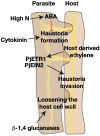Rooting for survival: how plants tackle a challenging environment through a diversity of root forms and functions
- PMID: 39657006
- PMCID: PMC11663570
- DOI: 10.1093/plphys/kiae586
Rooting for survival: how plants tackle a challenging environment through a diversity of root forms and functions
Abstract
The current climate crisis has global impacts and will affect the physiology of plants across every continent. Ensuring resilience of our agricultural and natural ecosystems to the environmental stresses imposed by climate change will require molecular insight into the adaptations employed by a diverse array of plants. However, most current studies continue to focus on a limited set of model species or crops. Root systems are particularly understudied even though their functions in water and nutrient uptake are likely pivotal for plant stress resilience and sustainable agriculture. In this review, we highlight anatomical adaptations in roots that enable plant survival in different ecological niches. We then present the current state of knowledge for the molecular underpinnings of these adaptations. Finally, we identify areas where future research using a biodiversity approach can fill knowledge gaps necessary for the development of climate-resilient crops of the future.
© The Author(s) 2024. Published by Oxford University Press on behalf of American Society of Plant Biologists.
Conflict of interest statement
Conflict of interest statement. None declared.
Figures




Similar articles
-
From phenotyping to genetic mapping: identifying water-stress adaptations in legume root traits.BMC Plant Biol. 2024 Aug 6;24(1):749. doi: 10.1186/s12870-024-05477-8. BMC Plant Biol. 2024. PMID: 39103780 Free PMC article. Review.
-
Root plasticity under abiotic stress.Plant Physiol. 2021 Nov 3;187(3):1057-1070. doi: 10.1093/plphys/kiab392. Plant Physiol. 2021. PMID: 34734279 Free PMC article. Review.
-
Rooting for resilience: central metaxylem area as a breeding target for yield gain and resilience in wheat (Triticum aestivum L.).BMC Plant Biol. 2025 Apr 21;25(1):493. doi: 10.1186/s12870-025-06523-9. BMC Plant Biol. 2025. PMID: 40259220 Free PMC article.
-
Hope in Change: The Role of Root Plasticity in Crop Yield Stability.Plant Physiol. 2016 Sep;172(1):5-6. doi: 10.1104/pp.16.01257. Plant Physiol. 2016. PMID: 27578845 Free PMC article. No abstract available.
-
Epigenomics in stress tolerance of plants under the climate change.Mol Biol Rep. 2023 Jul;50(7):6201-6216. doi: 10.1007/s11033-023-08539-6. Epub 2023 Jun 9. Mol Biol Rep. 2023. PMID: 37294468 Review.
Cited by
-
Divide and survive: PuZFP1 coordinates dual root developmental pathways for drought adaptation in Populus.Plant Physiol. 2025 Jul 3;198(3):kiaf261. doi: 10.1093/plphys/kiaf261. Plant Physiol. 2025. PMID: 40578311 Free PMC article. No abstract available.
-
CrWRKY57 and CrABF3 cooperatively activate CrCYCD6;1 to modulate drought tolerance and root development.Hortic Res. 2025 Jun 20;12(9):uhaf158. doi: 10.1093/hr/uhaf158. eCollection 2025 Sep. Hortic Res. 2025. PMID: 40861037 Free PMC article.
References
-
- Abd Elhalim ME, Abo-Alatta O, Habib SA, Abd Elbar OH. The anatomical features of the desert halophytes Zygophyllum album L.F. and Nitraria retusa (Forssk.) Asch. Ann Agric Sci. 2016:61(1):97–104. 10.1016/j.aoas.2015.12.001 - DOI
-
- Ameloot E, Verheyen K, Hermy M. Meta-analysis of standing crop reduction by Rhinanthus spp. and its effect on vegetation structure. Folia Geobot. 2005:40(2–3):289–310. 10.1007/BF02803241 - DOI
Publication types
MeSH terms
Grants and funding
LinkOut - more resources
Full Text Sources

